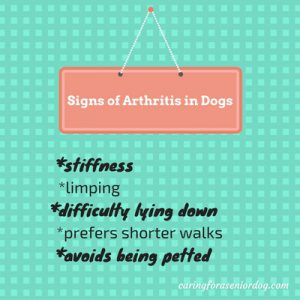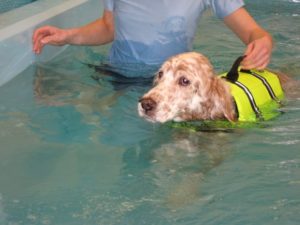
A common issue yet one too often ignored by pet parents, it’s time to address arthritis and dogs.
I literally want to cry when I speak to people with dogs who are obviously in pain, yet they assume it’s a natural part of aging and don’t do anything to help. Of course I suggest they go to the vet immediately. Naturally I explain how many options there may be but I can only recommend, I can’t physically drag them, although I wish I could.
Does my dog have arthritis?
Dogs can be pretty good at hiding pain, so you may not realise the extent of your dog’s discomfort until his condition has become quite advanced.
Have you noticed any of the following?
- Stiffness when your dog gets up in the morning, or after a nap
- Difficulty lying down
 Reluctance to move around as much as he used to
Reluctance to move around as much as he used to- Stopped jumping onto the couch
- Prefers shorter walks
- Not running around with his mates at the dog park
- Overweight dog having trouble walking – it may be more than just his weight
- Trouble/avoiding climbing stairs
- Limping
- Uncomfortable in certain positions
- Avoids being petted/touched
If you’ve answered yes to one, a few, or all, there’s a good chance your dog has arthritis.
Since these changes typically happen very gradually, you may not notice them at first, assuming it’s a natural part of aging. For that reason it’s important to pay close attention to your dog, as even subtle changes should signal a vet visit.
Catching the first signs of arthritis, or any condition, could mean a much better prognosis and a more comfortable life for your dog.
Are some breeds more likely to get arthritis?
While older and larger breeds are more susceptible to developing arthritis, any dog can develop it.
Causes
Many joint diseases are actually the result of a trauma or minor injury sustained in the past, even at quite a young age.
Cervical trauma caused by a walker jerking the leash attached to a collar, in a bid to stop him from pulling.
Strain on tendons and ligaments caused by excess weight
Lack of exercise – dogs need exercise every day, not just on the weekends. Putting an out of shape dog through a lot of physical exertion two days of the week, and barely any the other five days, is an injury waiting to happen.
 Overweight or obese pets
Overweight or obese pets
Dislocated joint
Inherited
Trauma
Joint infection
Bone fracture involving a joint
Aging and natural wear and tear
Autoimmune disorders
Can arthritis be prevented?
You’ve just read about the causes of arthritis, so let’s look at a few and see.
Because arthritis can develop as a result of an injury, treating that injury and making sure it heals properly is important.
All dogs need physical exercise every day, so make sure your dog is getting enough.
Keep your dog at a healthy weight, as obesity not only can cause arthritis and make the pain of existing arthritis worse, it can lead to many other health issues as well.
Teach your dog to walk nicely on a leash, so there’s no pressure put on his neck.
How is arthritis diagnosed?
Your vet will have a chat with you, asking what changes you’ve noticed and what your concerns are. He will conduct a thorough examination, ask to see your dog walk, and order any tests he deems necessary to make his diagnosis. It would be very helpful for the vet if you made a video of your dog when you notice him having difficulties.
Treatment
There are “traditional” options like medications, as well as those that are more natural or holistic.
Natural arthritis relief
Many people prefer a more natural, holistic route to healthcare in their own lives, and that has quickly translated into wanting the same for their pets. As the desire for more natural products grows, many veterinary practices are introducing alternative protocols.
What do these terms mean?
Before we begin let’s look at what these terms mean – alternative, natural, herbal medicine, holistic, supplement, nutraceutical.
Dictionary definitions
Alternative – “…Medical products and practices that are not part of standard care.” For example: treating heart disease with chelation therapy
Herbal Medicine – “The practice of using medicinal herbs to promote health, prevent and/or treat disease”
Holistic – “Identifying with principles of holism in a system of therapeutics, especially one considered outside the mainstream of scientific medicine, as naturopathy or chiropractic, and often involving nutritional measures”
Homeopathy – “…or homeopathic medicine, is a medical philosophy and practice based on the idea that the body has the ability to heal itself”
Natural – “Anything that occurs in nature or is produced naturally; it is not artificial, synthetic, or manufactured”
Nutraceutical – “… a broad umbrella term that is used to describe any product derived from food sources with extra health benefits in addition to the basic nutritional value found in foods.”
Supplement – “Something added to a food or a diet to increase its nutritional value” or “Nutritional supplements include vitamins, minerals, herbs, meal supplements, sports nutrition products, natural food supplements, and other related products used to boost the nutritional content of the diet.”
The holistic approach to treatment
In a more holistic approach to veterinary medicine, (and I should say human medicine as well!), drugs are viewed as merely treating symptoms, without much, if any, investigation into understanding why the problem developed in the first place.
There is a concern that when symptoms are masked for long periods of time (due to drugs), it not only makes it harder to treat the problem, other serious problems can develop that will go unseen.
Will it work for my dog?
Every dog responds differently, so a blanket yes or no cannot be given. Many dogs respond extremely well, while others show no improvement. In these cases, medication will likely be needed to keep him comfortable and pain free.
If you are interested in exploring this area of veterinary care, find a reputable holistic vet, and make an appointment for a consultation.
How long will it take for my dog to feel better?
Another question that should be asked of your vet, and the answer will be an estimate. No one can put an exact number to an arbitrary question.
I can tell you that dogs that take “drugs” will improve quite quickly, but there’s always the risk of side effects. Nutraceuticals take a long time to work, and dogs may not show improvement for weeks, or months, but there are no side effects.
Speak to your vet
Below you will find information about various therapies and supplements that have been successful in the treatment of arthritis in many dogs. Having said that, I strongly recommend you speak to your vet before implementing any changes.
Physical therapies
Massage
Daily massage helps increase circulation, and the good sensations block the bad ones.
Hydrotherapy
 Soaks in: warm water with Epsom salt – hot tub – whirlpool
Soaks in: warm water with Epsom salt – hot tub – whirlpool
Gentle swimming, starting with just a couple of minutes. A life jacket may help him feel more relaxed.
Exercise on an underwater treadmill
Acupuncture and chiropractic treatment
Many dogs respond well to both treatments, but do be careful to only deal with reputable and experienced practitioners.
Your dog’s bed
A heating pad added to your dog’s bed will help relax muscles and increase circulation. Alternatively, he may benefit from an orthopaedic bed. Some contain magnets, which evidence suggests reduces arthritis pain.
Supplements/Nutraceuticals
Supplements cannot fix/change calcium deposits, scar tissue, cartilage tears or other structural damage to a dog’s joints. They can, however, help decrease inflammation, and help the body to repair.
Glucosamine and Chondroitin Sulfate
Mention the word arthritis (be it dogs or humans), and you’ll hear the words Glucosamine and Chondroitin Sulfate. They are the most commonly used nutraceuticals in pet health care.
Glucosamine
Glucosamine is an amino sugar produced naturally in the body. It plays a key role in the production of joint lubricants and shock absorption, protects the cartilage in the joints against further degeneration, relieves pain, and improves mobility.
As a nutritional supplement it is extracted from crab, lobster, or shrimp shells. The fact that shells are usually discarded, allows for a constant and cost effective source.
Choose Glucosamine Sulphate when shopping.
It can take several weeks before seeing any noticeable improvements, several months for real results. Results can range from dogs who couldn’t walk, to being able to go for long walks, and even runs, to no improvement. Overall, people are very pleased with the results they’ve seen in their dogs.
Chondroitin Sulfate
Chondroitin is naturally found in animal cartilage, and the supplement is derived primarily from bovine cartilage, but also comes from sharks and whales. The source does not seem to influence its’ efficacy. Chondroitin sulfate addresses the disease process itself, doesn’t just mask the pain like drugs do.
It may:
- Help the body repair damaged cartilage
- Restore joint integrity
- Prevent stress injuries to joints
- Help repair damaged connective tissue
- Protect existing cartilage from premature breakdown
- Keep cartilage tissue hydrated
Because chondroitin production decreases with age, supplements may be particularly helpful for older dogs with arthritis.
Other anti-inflammatories
A complete run down of all the anti-inflammatories available is best left to a conversation with a professional. However, here is a brief list of a few that are well known.
New Zealand Green-lipped mussel
They contain a very high concentration of omega-3s, and are an excellent source of glucosamine and chondroitin.
Sea cucumber
Contains anti-inflammatory properties, helping to eliminate pain, and provide essential nutrients required by cartilage.
Methylsulfonylmethane (MSM)
MSM blocks the transfer of pain impulses through the nerve fibres, by enhancing cortisol production, a natural anti-inflammatory hormone produced by the body.
If you prefer to rely on food for MSM, the best sources are raw, organic meats and bones.
Organic apple cider vinegar
Added to food.
Fish oil – omega 3 fatty acids
Fish oil reduces inflammation, but avoid liver oil. It is low in omega 3s, and could be dangerous in the high doses needed to be effective.
SAMe
Is a liver support, but can also reduce pain, stiffness, and inflammation caused by arthritis.
Herbs and vitamins
Certain herbs help reduce inflammation, and one of the best is turmeric (which is recommended daily for adults). Vitamin C and E may also help.
Bromelain is an enzyme found in pineapples, and is said to have strong anti-inflammatory properties.
“Traditional” pain relief
NSAIDs (non-steroidal anti-inflammatories)
Most drugs used for treating arthritis in dogs are non-steroidal anti-inflammatories. Aspirin and ibuprofen, which most of us keep in our medicine cabinets, are just two examples. That was not a suggestion to pull them out and give them to your dog! I just wanted to present a relatable example.
How they work
They help reduce swelling, stiffness, and joint pain.
Side effects
Side effects are rare, side effects are common. Don’t you wish things were black and white? Yes or no?
Let’s put it this way. When you fill a prescription for yourself, there’s always a very long list of potential side effects included in the box. Usually nothing happens, but sometimes they do, so the companies just want you to be aware of potential problems.
Same goes for this!
These medications are very beneficial, with a good track record, but things happen. Monitor your dog for any changes in behaviour – eating, drinking, skin redness, vomiting, diarrhea. If yes, call your vet immediately.
When side effects do happen, they can come on quite suddenly, and by the time you notice them, the problem could be well advanced.
Side effect may include: gastric ulcers, problems with kidneys, liver, intestines, digestion, bleeding disorders.
Can I reduce the risks associated with NSAIDs?
Don’t combine them with steroids.
If you’re seeing a new vet who doesn’t know your dog’s history, be sure to tell him/her all medications your dog is taking, to avoid clashes.
Any changes in your dog, no matter how slight or insignificant you may think it is, call your vet immediately.
Give with food to help prevent gastric ulcers.
Have blood work done before beginning treatment. The results will be used as a reference against follow up blood tests, done to monitor liver and kidney function.
Steroids
Steroids may be prescribed if NSAIDs are not having any effect. Prednisone and other corticosteroids will reduce swelling and inflammation, but there are risks, particularly if they are used long term.
Some of the risks and side effects include:
- Liver damage
- Gastric ulcers
- Kidney damage
- Seizures
- Pancreatitis
- Diabetes
- Increased thirst
- Increased peeing
- Further damage to the joints
Unlike some drugs that you stop taking when the treatment is done, you must gradually wean your dog off steroids in order to get the adrenal glands used to not getting them.
Controlled medications (narcotics)
Another groups of medications are known as narcotics. I don’t know about you, but when I hear the word “narcotics” I think heroin, cocaine – maybe that comes from watching too many police dramas on television!
They are the most efficient pain relief, and although they’re addictive, they don’t have the same potential for organ damage as NSAIDs.
This category contains drugs like: Hydrocodone, Vicodin, Oxycodone to name just a few.
Because narcotics are listed as controlled substances, they aren’t available everywhere.
Tramadol
There seems to be many differences of opinion about whether or not Tramadol is a narcotic. Because it’s unclear, I have put it under its’ own heading.
I’m at the vet a lot these days, and it seems every time I’m there, someone is being prescribed Tramadol. It provides pain relief, but isn’t much help as an anti-inflammatory.
Tramadol is less controversial than narcotics, and generally safer than NSAIDs.
It has been known to cause feelings of euphoria, which may reduce anxiety in pets.
It may be unsuitable for use in dogs suffering from liver or kidney disease, seizures etc… but of course your vet will advise you if it’s right for your dog.
Like steroids, your dog needs to be weaned off Tramadol. Your vet will advise you on the schedule.
Side Effects
Tramadol doesn’t typically cause harmful side effects, unless it’s misused, but they can happen:
- Nausea
- Constipation
- Drop in heart rate
- Dizziness
- Panting
Lifestyle changes to make your arthritic dog more comfortable
Our most important goal in caring for our arthritic dog, is to make sure he is as comfortable, and pain free as possible. Here are some quick lifestyle changes we can make.
Food and water bowls
I started elevating my dog’s food and water bowls about a year ago, and the added height seems more comfortable for her. I stand them on a nonslip surface, so they don’t move around. My  senior dog is blind, so that’s particularly important.
senior dog is blind, so that’s particularly important.
Test different heights for comfort level, but your dog shouldn’t have to stretch up to reach. If you’d rather buy a set of raised bowls, there are lots of styles, sizes and heights to suit every need.
Beds
If your dog seems to have trouble settling, perhaps it’s time to make some changes to his bed. You can try adding a heating pad to what he’s using now, or perhaps a blanket for extra padding.
If you are considering buying a new one, there are lots of wonderful options to choose from including orthopedic and self warming beds. One thing that is important to take note of. Some beds have very high sides which may make going in and out a bit of a struggle. I buy beds that have 3 raised sides because the dogs love having something to lean against, but are low in the front so there’s nothing to climb over.
Play
Your dog still needs to play, but your vet will help you determine what type and duration is safe.
Assisted Living Devices
There are several “assisted living” products available, depending on the needs of your dog. Things like wheelchairs, slings, harnesses, ramps…
Ramps are handy for pets needing help getting in and out of the car, or having trouble using stairs. Be sure to make the slope as gradual as you can. Carpeted pet stairs means your dog still  has access to your bed, or living room furniture.
has access to your bed, or living room furniture.
A pet stroller is another great help. I bought one quite some time ago for one of my dogs, and it was worth every penny. It’s lightweight with tons of amazing features. Now I take her on long walks, and I get some much needed exercise.
Nail care
Nails that are too long make walking uncomfortable. Because the quicks on older dogs nails tend to be quite long, very little of the nail can be trimmed at a time. That means more frequent visits to the groomer, unless of course you do it yourself.
Frequent peeing
Arthritis can make it harder for your dog to get up to go out as often as he needs, so beds with waterproof liners and waterproof removable covers are a good option.
In this house we use pee pads…and lots of them! At night I cover the floor around my dog’s bed so if she has to pee overnight – which she often does – she pees, then goes back to sleep.
Flooring
Slippery floors and arthritic dogs are not a good combination. I’m not suggesting you invest in wall to wall carpeting, but perhaps add some throw rugs with a nonslip padding underneath, carpet squares or other padded surfaces, to help your dog be more sure footed.
Make sure you also buy a good enzymatic cleaner and stain remover, for accidents.
Arthritis and dogs – conclusion
I find it encouraging, knowing how much can be done to help dogs suffering the effects of arthritis. Many of us don’t realise how much pain our pets may be in, and because they’re so good at hiding it, don’t find out until it’s severe.
I talk a lot about the importance of speaking to your vet if ever you notice a change in your dog’s behaviour, and I’m going to keep preaching that advice.
If you have any tips, advice or stories you’d like to share about arthritis and dogs, please do so in the comment section below, or on my Facebook page.

 Mobility Aids For Dogs
Mobility Aids For Dogs
Lots of great info! Our Zeus had arthritis for years, and Tut has been showing signs in the past year or so. Management is key.
Thanks Nichole. I think it’s so encouraging to know, even if our dogs do get arthritis, there are so many things we can do to help manage the condition, and keep them enjoying life.
I always keep an eye out for signs of arthritis. Mr. N had a leg fracture as a puppy so I worry that it might bother him later on but so far, so good.
Sorry to hear that Mr. N. It’s good you’re keeping an eye out, because an injury can cause arthritis later in life, but it doesn’t mean it will which is really encouraing.
Its so important to spot the signs of ageing early so owners can help their pets manage symptoms. Theres a lot that can be done to relieve the joint pain associated with arthritis.
I agree, there is a lot that can be done, so when I see a dog in obvious pain, and the human tells me nothing’s being done, of course I have to explain the options. I always hope the message gets through.
We are just starting to see some signs with Ruby and have started her on New Zealand’s Best which has the green-lipped muscle in it. We have definitely noticed a difference since starting this supplement. Her stiffness often seems made worse by colder temps. She doesn’t much like going outside when it gets cold, but I know keeping her loose and getting exercise is important.
Isn’t it amazing how much we can help our pets when we keep a close eye, and notice changes immediately? New Zealand green lipped mussels are supposed to be amazing for arthritis, and it’s great to hear how much of a difference it’s making. Does she like wearing sweaters outside? Have you noticed a difference when she does wear one? Red couldn’t handle being outside in the cold if she wasn’t bundled up.
Great info thank you, especially as Layla will be 10 in January and am watching her closely
Thanks Ruth. I wish more pet parents watched their pets for signs of change as you do.
What a great, comprehensive article! Regardless of whether people believe that pain comes with age or not, we need to teach them that pain isn’t acceptable no matter what the cause. There are many different ways to address pain and there is no excuse to let a pet suffer. And the most effective arthritis and pain management is free – weight management.
Thank you Jana, I appreciate that. I agree with you, people have to understand allowing our pets to feel pain, no matter the reason, is unacceptable. There are too many effective pain management solutions, suffering is never an option. Weight management is definitely top of the list!!
This is a VERY inclusive and well written article. I have thought of using a heated pillow for our pup. I am going to go ahead and give it a try.
Thanks Joely. It’s very warm where Red sleeps, but sometimes I drape her blanket over a radiator for a few minutes, then cover her with it. Boy is she in heaven, I should imagine your dog would get as much pleasure from a heated pillow.
That fat dog! That’s so sad and makes me angry. Arthritis is so painful and when we can help our pets feel better and live longer, healthier lives and choose not to, it makes me angry. Thanks for sharing all these great tips and ideas.
I feel the same way Tonya. When I see fat dogs in the park I feel sick. I do my best to approach the person, make a fuss of the dog, then work in the dog’s weight into the conversation. Unfortunately I don’t know what they do with my advice, but hopefully they care enough about their dogs to do something.
I love this post! It is so thorough and informative! Every winter I watch my neighbors carry their 12-year-old mix breed down their front steps and sometimes even all the way to his favorite patch of grass. It always makes me look at my guy and think about what I can be doing to ward off as much arthritis as I can. These tips are great and I’m definitely going to make note! Thanks for taking the time to write this 🙂
I’m so glad! Of course the first thing I wonder is are your neighbours doing anything to help their dog with his pain. I can’t help myself, when it comes to animals it’s hard not to stick my nose in.
What a wealth of information you’ve provided for those who have fur children with arthritis.
Thanks very much. I know how much I appreciate articles filled with a ton of information, so I do my best to write the types of articles I would like to read.
Cats get arthritis too, we noticed it in Peanut when she got to about 18, but she was nible enough for the rest of her life due to good food, and some gentle supplements.
They definitely do. It’s so wonderful to know how much is in our control to keep our pets as healthy and happy as possible,
You have written one of the most comprehensive posts on Arthritis I’ve seen. We have been working with Shasta’s arthritis for quite a while now and even so, you’ve reminded me about several things I’ve been wanting to try but haven’t yet. Thank you for such an excellent resource!
Wow, thanks Denise how kind of you to say. I’m really glad you’ve found it useful. Hope Shasta’s doing well.
Hindy i simply loved this post having worked with a vet as an assistant for a couple of years i am aware of most of these options but most pet parents just accept arthritis as an ageing process and do nothing about it. I was clueless about the sea cucumber that is something new that i have learned now thanks to you
Thank you Malaika. Most pet parents do accept it and as a result, their pets are in pain. There are so many options to keeping arthritic pets comfortable, there is no reason for them to suffer.
Thank you for advocating for senior dogs. As pet parents, we MUST do everything we can to keep them comfortable, for as long as possible.
What can I say, I have a soft spot for seniors!! I couldn’t agree with you more – it is our responsibility to do the best we can for them, and whoever isn’t prepared to take that on, shouldn’t have a pet.
It is amazing how such a variety of treatments can help reduce the pain of arthritis. My sister had a senior lab with arthritis and acupuncture worked really well for her. I am interested in learning more about massage and arthritis.
I’m glad to hear acupuncture made such a difference to your sister’s dog, and improved her quality of life in the process. It’s wonderful to know there are options, and simply accepting a dog will be in pain should never be an option.
Wonderful extensive article, Hindy. Arthritis is something I am very familiar with and have dealt with/am dealing with four of my Huskies now that they are “seniors” (but don’t tell them that)! I use quite a few of these therapies…with a special needs Husky (Gibson, who had epilepsy), we have a deck ramp and a car ramp. Massage and laser therapy is wonderful. I also give them special vitamin and food supplements to help their joints and manage pain, and my one girl, the senior senior, she is on Tramadol as needed. She can not be on an anti-inflammatory due to GI issues. We are so fortunate that today we have so many options to help manage their pain and stiffness due to arthritis. I’ll be Pinning your post for sure to share with others.
Thanks Dorothy, I’m so glad you found it informative. I’m always interested in hearing what other people do for their pets, I love hearing about their successes, especially with alternative therapies.
I’m glad to see that there are so many options for helping a dog with arthritis! I knew there were a few, but I had no idea that this much was available. You may not be able to stop all of the issues that come with age, but being able to slow them down or control them a bit is comforting.
So am I! There’s no reason why our pets should suffer when there are so many options out there.
My parents’ dog is getting older and he is definitely experiencing some trouble moving especially with his joints. We’ve been giving him some supplements and have him on a special diet that has helped a bit. Otherwise we make sure he gets exercise but does not over exert himself.
Hi Jessica, I’m sorry to hear that, but I’m glad what you’re doing has been helping. I know someone who uses Best Vet Glycan Plus Glucosamine and absolutely loves it. She says it has made a huge difference for her dog, you might want to look into it.